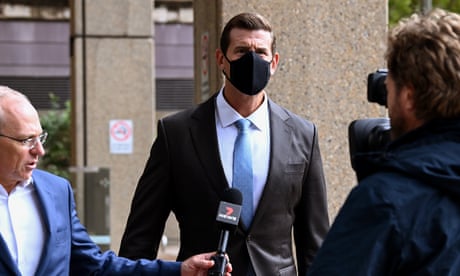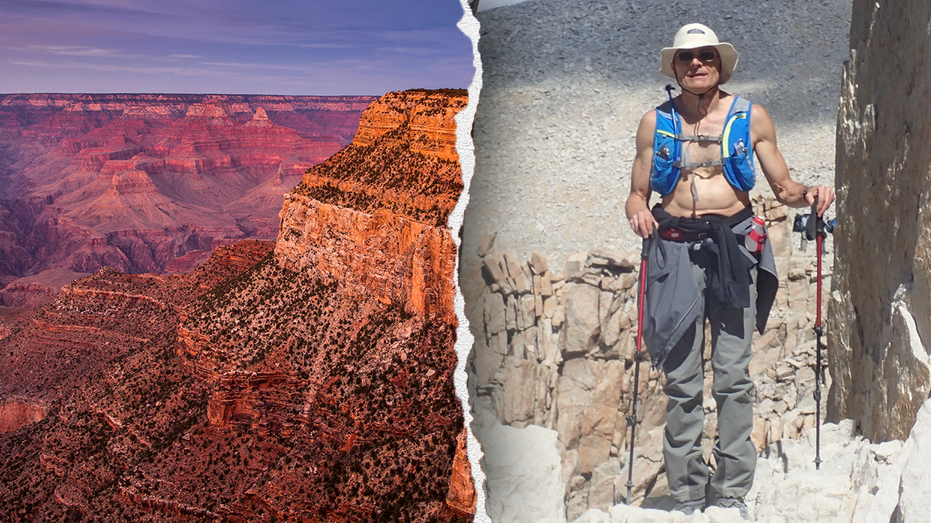- by foxnews
- 23 May 2025
Ben Roberts-Smith: how the soldier’s newspaper defamation suit went from battlefield to backyard
Ben Roberts-Smith: how the soldier’s newspaper defamation suit went from battlefield to backyard
- by theguardian
- 20 Feb 2022
- in news

At the end of two torrid days in the witness box, the questions came relentlessly, rapidly at Emma Roberts.
Asked to recount the moments and months when her marriage to decorated war veteran Ben Roberts-Smith slowly eroded, and then, suddenly, fell apart, she remained composed.
She told the court calmly of her growing suspicions her husband was having an affair, of the secret phone that would occasionally buzz in their bedroom, of his absences, his burying of secret items in the backyard. And finally, she detailed the arrival on her doorstep of the woman her husband had promised did not exist.
Roberts, however stoic, was a reluctant witness, appearing for the newspapers her ex-husband is suing for defamation under force of a subpoena.
Roberts-Smith's lawyer, Bruce McClintock SC, however, put it to Roberts time and time again during cross-examination that she had taken the stand in order to destroy her ex-husband and the reputation he had earned. It was put to her that her testimony about her ex-husband's affair was untrue; that nothing was ever buried in her backyard, as her ex-husband has told the court; that she "was quite prepared to lie" to discredit the man sitting impassively in the far corner of the courtroom.
Over and over it was asserted she was lying to harm Roberts-Smith.
"I bet you're here to inflict as much damage upon him as you can," McClintock said.
"No," Roberts said. "I hope Ben survives this nightmare."
The defamation trial brought by Roberts-Smith resumed early this month after more than half a year in abeyance because of Covid travel restrictions and shutdowns.
Roberts-Smith, the recipient of the Victoria Cross, is suing the Age, the Sydney Morning Herald and the Canberra Times for defamation over a series of reports he alleges are defamatory and portray him as committing war crimes, including murder, as well as acts of bullying and domestic violence.
The newspapers are pleading a defence of truth. Roberts-Smith denies wrongdoing.
These three weeks of the trial have been focused on the evidence of witnesses subpoenaed by the newspapers, seeking to back up the allegations made in a series of reports in 2018.
These are the key elements since the hearing resumed this month.
The court heard from an army medic, known to the court as Person 16, who served alongside Roberts-Smith during an operation in Fasil, in southern Uruzgan province, in November 2012.
"Outside the wire" on their last operation before returning home to Australia, Person 16 testified he and another soldier trained their weapons on an approaching Toyota Hilux ute and waved it to a stop.
Person 16 told the court he took into custody and handcuffed two of the four men inside the vehicle: an older man with a full beard and a younger man.
Neither man was armed, Person 16 testified, but components for an improvised explosive device were found inside the vehicle.
He said both were handcuffed and taken to a nearby compound for tactical questioning. Person 16 handed both prisoners over to Roberts-Smith, he told the court, and did not see the two men again.
Person 16 said that about 15 minutes after handing over the two men he heard Roberts-Smith say over the troops' radio "two EKIA". EKIA is a military initialism for "enemy killed in action".
In the days after the mission, Person 16 told the court he crossed paths with Roberts-Smith in their accommodation lines at the SAS's Camp Russell within Australia's Tarin Kot base.
He said he asked Roberts-Smith: "What happened to that young fella who was shaking like a leaf?"
Person 16 told the court Roberts-Smith replied: "I shot that cunt in the head. Person 15 told me not to kill anyone on the last job. So I pulled out my 9mm, shot the cunt in the side of the head, blew his brains out. It was the most beautiful thing I've ever seen."
Giving his evidence-in-chief, Person 16 was shown pictures of a dead Afghan male who he identified as the teenager he had taken into custody.
The body was photographed with an AK-47 variant beside it. Person 16 said the young man was not armed when he handcuffed him.
Under cross-examination, Person 16 was challenged by Roberts-Smith's lawyers that the later barrack-room conversation about the alleged murder was a fabrication, "something you have imagined".
"I am 100% certain beyond any doubt that that conversation took place," Person 16 responded. "His reply shocked me to the core, and that's why I remembered it."
Asked whether he could confidently identify the body in the photographs he'd been shown as the teenager he had taken into custody, Person 16 told the court: "The more I think about it, the more I'm confident this was the person that was in the Toyota Hilux."
In his evidence to the court last year, Roberts-Smith was asked about the alleged killing of the Afghan teenager.
He said the account was "baseless", that he never said those words, and that the event could not have happened, because he never fired his pistol in combat while on deployment in Afghanistan.
"I never had to engage with my pistol," he told the court.
In his previous testimony, Roberts-Smith also rejected assertions he ever engaged in the practice of using "throw-downs" - compromising equipment, such as a radio or weapon, carried by soldiers and placed on the bodies of victims as a post-facto justification for their killing.
Roberts-Smith has consistently maintained all of his actions in Afghanistan abided by the Australian troops' rules of engagement.
Emma Roberts is the only witness the court has actually seen over these three weeks.
The courtroom is closed to visitors, and vision of the hearing is sent out over a limited live stream because of national security concerns. Every other witness has been anonymised before the court, and not shown on camera.
Roberts told the court she had suspected for months her husband was having an affair - which he denied - before she was confronted by her husband's lover on the doorstep of her own home in April 2018.
Roberts said the woman, referred to in court as Person 17, appeared at her home unannounced, and with a black eye. The newspapers allege it was caused by Roberts-Smith striking her. He denies that and has told the court she fell down the stairs, intoxicated, at a function at Parliament House.
Person 17 will appear as a witness for the newspapers later this trial.
In her testimony, Roberts said with news of the affair set to become public, Roberts-Smith told his wife that she would lose access to their children if she didn't lie and claim they had been separated.
"Ben had suggested that the only way we would survive that [was] if we said we were separated, that I was to lie," Roberts said.
"I didn't want to lie. There were enough lies."
Roberts told the court: "He [Roberts-Smith] pointed to our children sitting in the lounge room, and he said 'if you don't lie you will lose them'."
Roberts told the court she was coerced into posing for a photograph to accompany a front-page story in the Australian newspaper the next day, saying the couple had been separated. She said the story was false.
Roberts also told the court she had suspected her husband was secretly burying cash around their Sunshine Coast home as their relationship faltered, and ultimately broke down.
She said she dug under a "very obvious" spot beneath a hose reel to find, not money, but a cache of six USBs secreted in a child's lunchbox. Roberts told the court a friend downloaded the contents of the USBs, and that she told her friend: "I do not want to see what's on them."
While the USBs are not, themselves, evidence in the defamation hearing, the court has previously heard they contained operational reports from SAS missions in Afghanistan, drone footage of military operations, classified images and hundreds of photos of SAS soldiers drinking in the Fat Ladies Arms, an unofficial bar at the Australian military base in Afghanistan.
Under cross-examination, lawyers for Roberts-Smith asserted Roberts had fabricated her evidence about the USBs and that nothing was found buried in the family backyard. Roberts told the court she stood by her testimony.
Lawyers put to Roberts she was motivated by malice, embittered by the end of her marriage to Roberts-Smith, citing acrimonious text messages written to friends during their breakup that described the former soldier as a "lying cheating cunt" and his career as the Titanic - that is, destined to sink.
"You did come to loathe him didn't you?," Roberts was asked.
"Not loathe him, no, but I was very angry."
Roberts was accused of "fabrication" of her evidence about her marriage and home life, saying her testimony was "an exercise in rank hypocrisy".
"No," Roberts replied.
Evidence this month has also focused on events at a compound called Whiskey 108 in the village of Kakarak, a known insurgent stronghold in Uruzgan province.
The newspapers allege that during an SAS operation there in 2009, two men were discovered in a secret tunnel inside Whiskey 108, an elderly man and another man with a prosthetic leg.
The court heard this week the men were captive, compliant and unarmed, but the newspapers have alleged Roberts-Smith ordered another soldier to execute the elderly man, before forcibly marching the disabled man outside the compound, throwing him to the ground and shooting him dead with his machine gun.
The man's prosthetic leg was later kept by another soldier and used as a drinking vessel at the Australian soldiers' unofficial bar on base, the court has heard.
In evidence for the newspapers this week, one soldier, Person 41, told the court Roberts-Smith and another soldier borrowed his suppressor, which he believes was then used in the execution of the elderly man.
Person 41 also testified he later saw Roberts-Smith "frogmarch" the man with a prosthetic leg outside the compound, throw him to the ground and machine-gun him to death.
Under cross-examination, Person 41 was questioned why he hadn't reported what he'd seen to his commanders.
"I just wanted to keep quiet about the whole thing," he told the court. "I was a new trooper, on my very first trip with the SAS, I just wanted to toe the line. It's the unwritten rule - you go along with whatever happens."
Arthur Moses SC, acting for Roberts-Smith, alleged Person 41 was lying about the killing. "You can't tell the difference between fact and fiction," he said in a heated exchange.
"Incorrect," Person 41 replied.
Another soldier at Whiskey 108, Person 14, gave evidence for the newspapers' defence that he saw an Australian soldier carrying a distinctive weapon, a Minimi machine gun, throw a human-shaped object to the ground and fire a burst of bullets into it. He told the court he later saw Roberts-Smith carrying a Minimi during that mission.
A third soldier, Person 42, also gave evidence for the newspapers that he helped pull "at least two" men out of the tunnel. He handed them over to other soldiers and never saw them again.
Moses, for Roberts-Smith, put it to Person 42 that his evidence was not true "because you weren't there".
"That is not true," the soldier replied.
Person 14's account was similarly challenged. "It didn't happen did it?" Moses asked.
"It 100% happened," Person 14 said.
"You have come here to throw Mr Roberts-Smith under the bus any way you can, haven't you?" Moses said. "No," Person 14 replied.
Roberts-Smith has consistently denied the newspapers' version of events at Whiskey 108, describing them as "completely false".
In his evidence last year, he said he never ordered an elderly man shot, and he killed the man with a prosthetic leg outside Whiskey 108 because the man was a legitimate target, armed and running away, and was killed in accordance with troops' rules of engagement.
He said no people were taken out of the tunnel in the compound.
"There were no people in the tunnel at Whiskey 108," he told the court.
Much of the cross-examination of these witnesses by Roberts-Smith's legal team has focused on the uncompromising, cliquey nature of the tightknit SAS regiment, its hierarchies - official and unofficial - and its personality clashes.
It has been put to witnesses that other soldiers, less effective in battle than Roberts-Smith, were motivated to tear him down, resentful of his success, his decorations and his apparent fearlessness.
Soldiers called to appear by subpoena have been questioned on their attitudes to Roberts-Smith, asked if they were jealous of him, or suffering an envy frustrated by their own shortcomings. Long-serving soldiers have had their own service records pored over, their reprimands examined, their mental health questioned in open court.
Some have spent a bare few hours in the witness box. Others have been days on the stand, asked to recount over and over some of the most difficult, intense and frightening moments of their careers.
Last year, Roberts-Smith told the court that following his investiture with the Victoria Cross - won for gallantry at Tizak in 2010 - attitudes of other soldiers towards him changed dramatically.
"For all the good it [the VC] has brought me and enabled me to do, it is unfortunately the case, in my instance particularly, that it has also brought me a lot of misfortune and pain.
"It put a target on my back."
This has been a brutal and uncompromising trial. It has many weeks to run: the newspapers have called barely a third of their 30-strong witness list. Roberts-Smith has flagged he may call up to 18 witnesses-in-reply.
But the shockwaves from the allegations and this subsequent trial have reverberated far beyond the dusty battlefields of Afghanistan and the close-confines world of the SAS.
For Emma Roberts, the hardest moment came when she was asked about the impact on her family, and how the allegations against her former husband had affected their young twin daughters.
She broke down recounting how one of her children had asked, amid the accusations and counter-claims, the secrecy and the stress: "Why doesn't Dad smile any more?"
- by foxnews
- descember 09, 2016
United Airlines flight returns to Hawaii after concerning message found on bathroom mirror; FBI investigating
United Airlines Flight 1169 to Los Angeles returned to Hawaii after a "potential security concern" aboard the plane. The FBI and police are investigating.
read more


